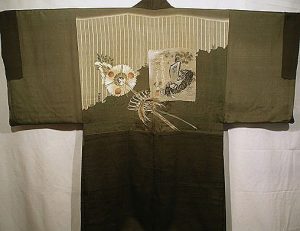Description
This is a very handsome and dramatic Informal Haori, or a topcoat that would have been worn only at home or visiting with very close friends. The Informal Haori are often the most luxurious of the Haori, as only the wealthiest of Japanese in times past could have afforded to wear such elegant Silk garments in the home. The outer layer of the Haori is hand woven of the finest and most lustrous dark brown Silk.
The inner lining of the Haori (shown left) is a sophisticated overall pattern of hand stenciled, rollicking horses. The mellow black and brown coloring is from natural dyes, while the painting itself was accomplished through the Rice Paste Resist technique. This method, used in the stenciling of this urbane Haori, required that each color be applied separately, while all the others were painted out in the rice paste. Each time a new color was added, the rice paste had to be removed by soaking it out over and over again in the local river water and then reapplied. This was an intense, tedious, and laborious process that required tremendous skill on the part of the artist. Stencils, in Japan, were works of art in themselves. The stencils were hand made layers of mulberry paper treated with persimmon tannin through which elaborate pictorial images were created. On this Haori, the design has been expanded to extend all around the interior of the garment, which is quite unusual.
The use of horses as the main motif on this Haori demonstrates that it belonged to an individual of the nobility. Horses were limited to the upper class, and it became one’s heavenly duty to ride a horse when one visited a Shinto Shrine. In addition, horses were often given as a prayer offering to shrines. The wealthy gave meticulously groomed, and luxuriously and decoratively trapped horse as gifts, while the poorer gave paintings of horses on wood (“Ema”). These can still be seen as valued works of art at many shrines in Japan today, while the famous Nikko Shrine still maintains its horses. This is another sign that the individual for whom this Haori was created belonged to an unusually high level of society as most individuals during the 1800s were not allowed any association with horses.
A Certificate of Authenticity is included.
TTAC will personally pack and ship via UPS at company expense within the continental U.S.









